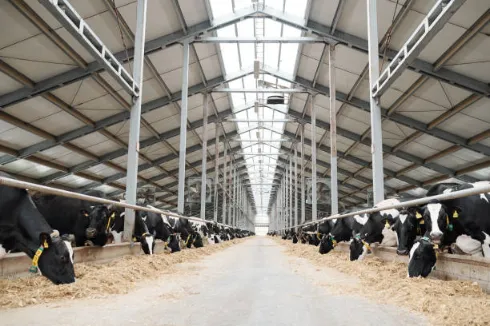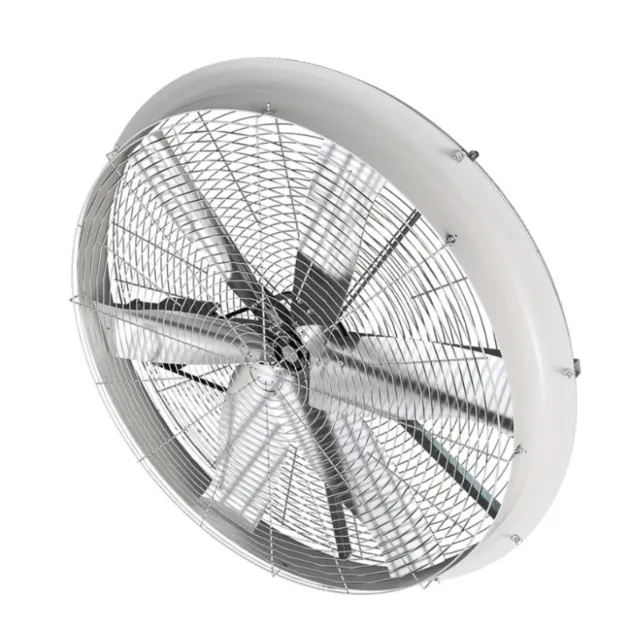The Effect of Heat Stress on Dairy Cattles

Introduction
Dairy farms across the United States face many daily challenges, but one issue is often underestimated, heat stress in cattle. Cows are highly sensitive to hot and damp weather. When barns get too warm, cattle reduce feed intake, produce less milk, and often fall sick. For farmers, this means big financial losses and extra work.
Today, more farms are turning to ventilation and cooling systems to solve this. It is not just about comfort anymore. It is about protecting animal health and farm income. Companies such as DAIHO provide equipment designed for barns, making climate control an essential part of dairy production.
What is Heat Stress in Dairy Cattle?
Defining Heat Stress
Heat stress appears when cows cannot get rid of body heat quickly enough. Farmers often use the Temperature Humidity Index (THI) to measure the risk. A THI level above 72 already puts cows under pressure. In hot states like Arizona and Florida, barns often cross this point during summer days.
Signs of Heat Stress in Cows
Farmers can easily see the changes in cattle when barns are too hot:
They eat less feed, which cuts milk yield.
They spend more time standing instead of lying.
Their breathing becomes faster, sometimes with open mouth panting.
Fertility rates fall, and calving becomes harder.
These are clear signals that barn climate has a strong effect on cow health.
Consequences of Heat Stress on Dairy Farming
Impact on Milk Yield and Quality
When cows are too hot, milk production goes down fast. Research in Wisconsin showed a 10–15% drop in daily milk output during warm months. It is not only the amount that falls. The fat and protein in milk also go down, making it less valuable.
Animal Health and Reproduction Problems
Long periods of heat stress raise the chance of mastitis and other infections. Cows under stress also have weaker immunity, which makes them more likely to get sick. Fertility is another big problem. Heat stressed cows are harder to breed, which slows down the whole herd’s growth.
Economic Losses for Farmers
Lower milk yield hits farmers directly in their pocket. Added to this are higher vet bills and more energy use if barns use weak or old cooling systems. Reports show U.S. dairy farms lose millions each year because of heat stress.
Solutions to Reduce Heat Stress in Dairy Barns
Mechanical Ventilation Systems
HVLS Ceiling Fans
One strong solution for large barns is the HVLS (High Volume, Low Speed) ceiling fan. These fans are huge, with blades as wide as 7 meters, and they move a lot of air slowly and gently. Unlike small, fast fans, HVLS fans cover big spaces with low energy needs.
Models like the DAIHO HVLS ceiling fan use permanent magnet brushless motors. These motors save power but still deliver smooth airflow. The blades are made from strong aluminum alloy, so they are light yet tough. On big farms in Texas, these fans cut barn temperatures by several degrees. Farmers reported calmer cows and higher milk yield even during very hot months.
Panel Fans
Panel fans are another common choice. They are square shaped and easy to install on barn walls. Unlike HVLS fans that move air across wide spaces, panel fans provide strong airflow for specific areas like feed alleys or resting spots.
The panel fan from DAIHO is built for farm use. It pushes steady air and is simple to mount. In barns across New York, panel fans are lined up along feeding areas. They help cows stay cool while eating, which keeps feed intake higher and supports milk output.
Cooling and Moisture Control
Cooling Pads
In hotter climates, farmers often pair fans with cooling pads. These pads are kept wet, and when warm air passes through, the air cools before reaching the cows. This method, called evaporative cooling, is cheaper and simpler than full air conditioning.
In California’s Central Valley, farms have seen air temperature fall by 5–8°C with cooling pads. This drop can be the difference between stressed cows and healthy cows.

Why DAIHO Equipment Fits Dairy Farms
Certified Quality and Durability
Barn equipment must survive dust, water, and ammonia. DAIHO’s ventilation systems for cattle farms are tested and carry ISO and CE certificates. This gives farmers peace of mind that the systems will keep running even in tough barn conditions.
Wide Range of Ventilation & Cooling Products
DAIHO makes many options: HVLS ceiling fans for wide barns, panel fans for direct airflow, and cooling pads for hot days. This mix means both small family barns and large dairies can find the right tools for their needs.
Proven Global Applications
DAIHO’s products are used worldwide, from Asia to Europe. They are already applied in dairy barns, poultry houses, and even greenhouses. Farmers can see these results and know the systems will also work in their barns.
Conclusion
Heat stress is a major hidden cost in dairy farming. It cuts milk yield, hurts cow health, and reduces farm income. But the right climate control can change this. By using HVLS ceiling fans, panel fans, and cooling pads, farmers can keep barns cooler, cows healthier, and milk production steady.
Companies such as DAIHO offer proven solutions. For dairy farmers dealing with rising summer heat, using modern ventilation and cooling is not just about comfort. It is about protecting cows and keeping farms profitable for the long run.
FAQ
Q1: What temperature causes heat stress in dairy cows?
A: Heat stress usually starts when the THI is above 72. In simple words, if it feels sticky and hot for people, cows are already stressed.
Q2: How can HVLS ceiling fans improve barn comfort?
A: HVLS fans move a huge amount of air slowly across the barn. This lowers hot spots and keeps cows cool without wasting much power.
Q3: Are cooling pads useful in humid regions?
A: Cooling pads work best in dry areas. But even in humid places, they still help when used with fans, since they cool incoming air.
Q4: What is the best mix of fans and cooling equipment for dairy barns?
A: Many farms use HVLS ceiling fans for large spaces, panel fans for key spots like feeding lanes, and cooling pads for very hot days. The right setup depends on barn size and local weather.
Q5: How often should barn fans and cooling gear be serviced?
A: At least once every season. Cleaning blades, checking motors, and flushing cooling pads keep the systems strong and long lasting.
